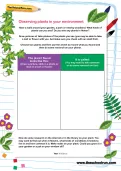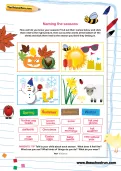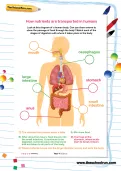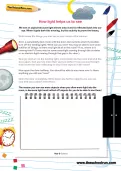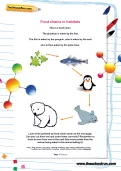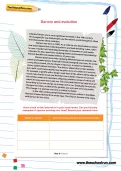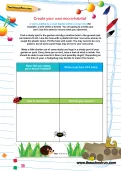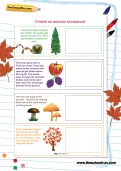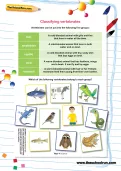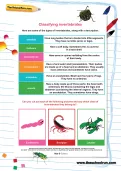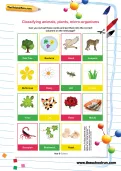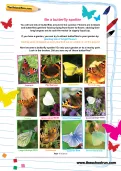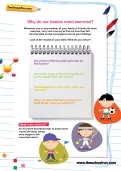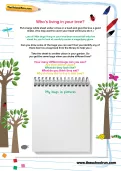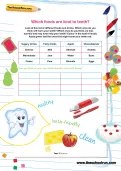Have a walk around your garden, a park or nearby woodland. What kinds of plants can you see? Do you see any plants in flower? Choose two plants and then use this sheet to record what you found and then do some research on your plants.
or
Register to add to your saved resources
Already a subscriber? to view this content.
How well do you know your seasons? Cut out their names below and stick them next to the right picture, then cut out the words at the bottom of the sheet and stick them next to the season you think they belong in.
or
Register to add to your saved resources
Already a subscriber? to view this content.
There are a few things human beings need to survive. Can you cut out all the cards and divide them between the two groups below?
or
Register to add to your saved resources
Already a subscriber? to view this content.
Look at this diagram of a human body. Can you draw arrows to show the passage of food through the body? Match each of the stages of digestion with where it takes place in the body.
or
Register to add to your saved resources
Already a subscriber? to view this content.
We see an object because light shines onto it and is reflected back into our eye. When it gets dark this evening, try this activity to prove the theory.
or
Register to add to your saved resources
Already a subscriber? to view this content.
Some of these things are living, some were once alive but are now dead and some have never been alive. Can you cut out the cards and group them in the circles?
or
Register to add to your saved resources
Already a subscriber? to view this content.
Look at these jumbled-up food chain cards. Can you cut them out and order them correctly? Remember to draw arrows from one to the next (the arrow points from the animal being eaten to the animal eating it).
or
Register to add to your saved resources
Already a subscriber? to view this content.
Have you heard about Darwin's theories on evolution? Have a look on the internet or in your local library. Can you find any examples of species evolving over time? Record your research.
or
Register to add to your saved resources
Already a subscriber? to view this content.
A micro-habitat is a small habitat within a larger one (for example: a tree within a forest). Today, you are going to create your own!
or
Register to add to your saved resources
Already a subscriber? to view this content.
Autumn is a great time for collecting! Why not go on an autumn treasure hunt and make a scrapbook with all the things you discover.
or
Register to add to your saved resources
Already a subscriber? to view this content.
There are five groups of vertebrates. Which of the following vertebrates belong to each group?
or
Register to add to your saved resources
Already a subscriber? to view this content.
Go out to your garden, local park or nearby woodland. Collect as many examples of flowering plants and non-flowering plants that you can find. Then choose one plant of each kind and draw a diagram of it.
Can you find the seeds in both plants? Can you find out what your chosen plants are called?
or
Register to add to your saved resources
Already a subscriber? to view this content.
Can you cut out each of the following pictures and say which class of invertebrates they belong to?
or
Register to add to your saved resources
Already a subscriber? to view this content.
Do you know the difference between animals, plants, micro-organisms? See if you can you put all these in the correct group.
or
Register to add to your saved resources
Already a subscriber? to view this content.
You will see lots of butterflies around in the summer. Flowers are in bloom and butterflies get their food by flying from flower to flower, sticking their long tongues out to suck the nectar (a sugary liquid) up. Can you spot any butterflies in your garden or to a nearby park. Look in the bushes. Did you see any of these butterflies?
or
Register to add to your saved resources
Already a subscriber? to view this content.
This line graph shows how much baby Jack weighed throughout his first year. Can you answer the following questions?
or
Register to add to your saved resources
Already a subscriber? to view this content.
Whenever you or any member of your family or friends do some exercise, carry out a survey to find out how they felt. Use the table to record your findings. Look at the results of your table. What do you notice?
or
Register to add to your saved resources
Already a subscriber? to view this content.
Put a large white sheet under a tree or a bush and give the tree a good shake. Lots of little bugs living in your tree/bush should fall onto the sheet for you to look at carefully under a magnifying glass. Can you draw some of the bugs you can see? Can you identify any of them?
or
Register to add to your saved resources
Look at this list of different foods and drinks. Which ones do you think will harm your teeth? Which ones do you think are less harmful and may even help your teeth? Colour in the tooth-friendly foods green and the ones that might harm your teeth red.
or
Register to add to your saved resources
Already a subscriber? to view this content.
Look at these different word cards. Can you sort them into types of plant and into functions? Now shuffle the cards and see if you can match the different plants with possible functions.
or
Register to add to your saved resources
Already a subscriber? to view this content.
